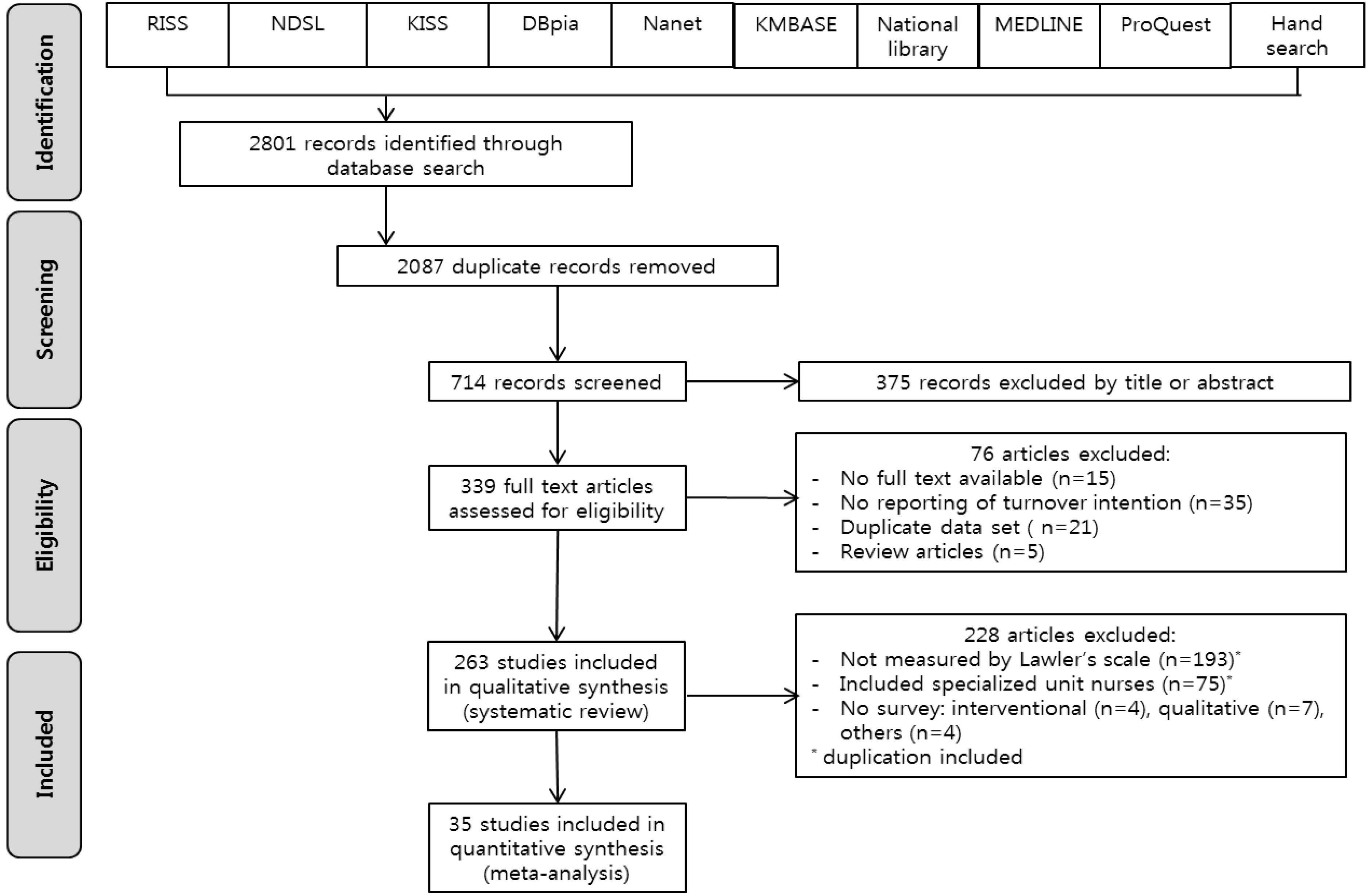1.Ministry of Health & Welfare, Ministry of Health and Welfare statistical yearbook 2016 [Internet]. Seoul: Ministry of Health & Welfare;2016. [cited 2016 March 9]. Available from. https://www.welfare24.net/ab-3124-176.
2.KHIDI . Survey of nurses's activities [Internet]. Cheongju: Korea Health Industry Development Institute;2014. [cited 2016 July 20]. Available from. http://www.khiss.go.kr/.
3.Hospital Nurses Association. Survey on the status of hospital nursing staff placement [Internet]. Seoul: Hospital Nurses Association;2016. [cited 2016 September 8]. Available from. http://www.khna.or.kr/web/information/resource.php.
4.Estryn-Behar M., Van der Heijden BI., Fry C., Hasselhorn HM. Longitudinal analysis of personal and work-related factors as-sociated with turnover among nurses. Nursing Research. 2010. 59(3):166–77. https://doi.org/10.1097/NNR.0b013e3181dbb29f.

5.Hayes LJ., O'Brien-Pallas L., Duffield C., Shamian J., Buchan J., Hughes F, et al. Nurse turnover: a literature review-an update. International Journal of Nursing Studies. 2012. 49(7):887–905. https://doi.org/10.1016/j.ijnurstu.2011.10.001.
6.Han K., Trinkoff AM., Gurses AP. Work-related factors, job satisfaction and intent to leave the current job among United States nurses. Journal of Clinical Nursing. 2015. 24(21-22):3224–32. https://doi.org/10.1111/jocn.12987.

7.Ayalew F., Kols A., Kim YM., Schuster A., Emerson MR., Van Roosmalen J, et al. Factors affecting turnover intention among nurses in Ethiopia. World Health & Population. 2015. 16(2):62- 74.https://doi.org/10.12927/whp.2016.24491.

8.Na BJ., Kim EJ. A study on the mediating and moderating effect of work-family conflict in the relationship among emotional labor, occupational stress, and turnover intention. Journal of Korean Academy of Nursing Administration. 2016. 22(3):260–9. https://doi.org/10.11111/jkana.2016.22.3.260.

9.Song MS. Influence of emotional labor on job involvement, job satisfaction, and turnover intention of clinical nurses. Journal of the Korea Academia-Industrial cooperation Society. 2014. 15(6):3741–50. https://doi.org/10.5762/KAIS.2014.15.6.3741.

10.Borenstein M., Hedges LV., Higgins JP., Rothstein HR. Introduction to meta-analysis. Chichester, UK;. John Wiley & Sons;Ltd. 2009. p. 1–452. https://doi.org/10.1002/9780470743386.
11.Bronfenbrenner U. Contexts of child rearing: problems and prospects. American Psychologist. 1979. 34(10):844–50. https://doi.org/10.1037/0003-066X.34.10.844.

12.Moher D., Liberati A., Tetzlaff J., Altman DG. Preferred reporting items for systematic reviews and meta-analyses: the PRISMA statement. British Medical Journal. 2009. 339:b2535. https://doi.org/10.1136/bmj.b2535.

13.Lawler EE. Satisfaction and behavior. New York: McGrow-Hill;1983. p. 287–301.
14.Joanna Briggs Institute. Joanna Briggs Institute reviewers' ma-nual: 2016 edition [Internet]. Australia: Joanna Briggs Institute;2016. [cited 2016 August 20]. Available from. https://joannabriggs.org/research/critical-appraisal-tools.html.
15.Lenhard W., Lenhard A. Calculation of effect sizes [Internet]. Germany: Lenhard W, Lenhard A;2016. [cited 2016 March 10]. Available from. https://www.psychometrica.de/effect_size.html.
16.Sutton AJ., Duval SJ., Tweedie RL., Abrams KR., Jones DR. Em-pirical assessment of effect of publication bias on meta-analy-sis. British Medical Journal. 2000. 320:1574–7. https://doi.org/10.1136/bmj.320.7249.1574.
17.Chan ZC., Tam WS., Lung MK., Wong WY., Chau CW. A systematic literature review of nurse shortage and the intention to leave. Journal of Nursing Management. 2013. 21(4):605–13. https://doi.org/10.1111/j.1365-2834.2012.01437.x.

18.Kim JH., Kim SJ., Park ET., Jeong SY., Lee EH. Policy issues and new direction for comprehensive nursing service in the national health insurance. Journal of Korean Academy of Nursing Administration. 2017. 23(3):312–22. https://doi.org/10.11111/jkana.2017.23.3.312.

19.Moon JH. Organizational culture, job stress and turnover intention among nurses in small and medium sized hospitals [master's thesis]. Seoul: Han Yang University;. 2012. 1–66.
20.The PLOS Medicine Editors. Observational studies: getting clear about transparency. PLoS medicine. 2014. 11(8):e1001711. https://doi.org/10.1371/journal.pmed.1001711.
21.Luthans F., Youssef CM. Emerging positive organizational behavior. Journal of Management. 2007. 33(3):321–49. https://doi.org/10.1177/0149206307300814.

22.Chen HC., Chu CI., Wang YH., Lin LC. Turnover factors re-visited: a longitudinal study of Taiwan-based staff nurses. International Journal of Nursing Studies. 2008. 45(2):277–85. https://doi.org/10.1016/j.ijnurstu.2006.08.010.

23.Yamaguchi Y., Inoue T., Harada H., Oike M. Job control, work- family balance and nurses' intention to leave their profession and organization: a comparative cross-sectional survey. International Journal of Nursing Studies. 2016. 64:52–62. https://doi.org/10.1016/j.ijnurstu.2016.09.003.
24.Chang HY., Shyu YI., Wong MK., Friesner D., Chu TL., Teng CI. Which aspects of professional commitment can effectively retain nurses in the nursing profession? Journal of Nursing Scholarship. 2015. 47(5):468–76. https://doi.org/10.1111/jnu.12152.

25.Korea Research Institute for Vocational Education and Training. Occupation status of emotional labor [Internet]. Sejong: KRIVET;2013. [cited 2016 May 5]. Available from. https://www.krivet.re.kr/ku/da/kuBDCVw.jsp?gn=G7-E520130008.
26.Leineweber C., Chungkham HS., Lindqvist R., Westerlund H., Runesdotter S., Alenius LS, et al. Nurses' practice environment and satisfaction with schedule flexibility is related to intention to leave due to dissatisfaction: a multi-country, multilevel study. International Journal of Nursing Studies. 2016. 58:47–58. https://doi.org/10.1016/j.ijnurstu.2016.02.003.

27.Heinen MM., Van Achterberg T., Schwendimann R., Zander B., Matthews A., Kózka M, et al. Nurses' intention to leave their profession: a cross sectional observational study in 10 European countries. International Journal of Nursing Studies. 2013. 50(2):174–84. https://doi.org/10.1016/j.ijnurstu.2012.09.019.

28.Chan EY., Morrison P. Factor influencing the retention and turnover intentions of registered nurses in a Singapore hospital. Nursing and Health Science. 2000. 2(2):113–21. https://doi.org/10.1046/j.1442-2018.2000.00046.x.
29.Yin JCT., Yang KPA. Nursing turnover in Taiwan: a meta-anal-ysis of related factors. International Journal of Nursing Studies. 2002. 39(6):573–81. https://doi.org/10.1016/S0020-7489(01)00018-9.

30.Johnson SL. An ecological model of workplace bullying: a guide for intervention and research. Nursing Forum. 2011. 46(2):55–63. https://doi.org/10.1111/j.1744-6198.2011.00213.x.





 PDF
PDF ePub
ePub Citation
Citation Print
Print



 XML Download
XML Download